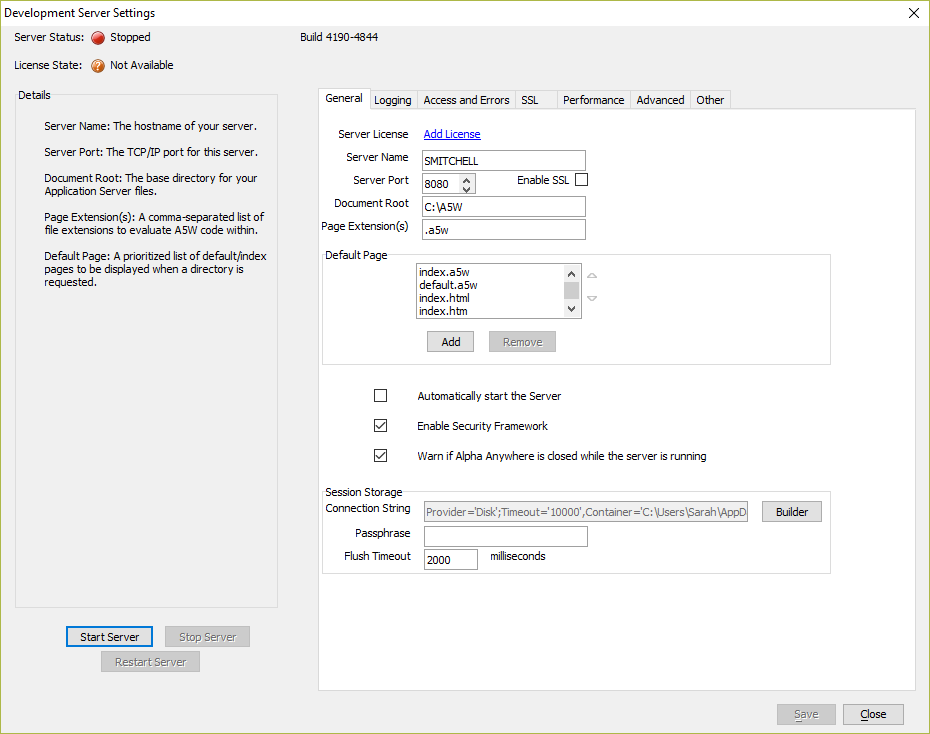General Settings
Description
The General tab controls the basic server settings used by the Application Server.
Settings
- Setting
- Description
- Server License
Add or remove licenses.
- Server Name
The host name of your server. This is the name used by the web clients to access your server.
- Server Port
The TCP/IP port this server will listen on for web requests. When using HTTP, port 80 is the default port for receiving requests from all standard web browsers. When using HTTPS (TLS/SSL), the standard port is 443. If there is already a web server running on the computer where you are using the Application Server, you will need to change either that server or the Application Server to use an inactive port. You can run HTTPS on port 80 if you would like, but you will have to use a URL such as https://server:80/page.a5w.
- Use dynamic server port
Development Server only. If checked, the Dveelopment Server will dynamically find an available port every time the server is started. This is useful in environments such as Terminal Server where multiple developers may be working on the same system at the same time and need to be able to run unique copies of the Development Server without conflicting with each other.
- Enable TLS/SSL
If checked, TLS (SSL) will be enabled on the server. Additional options for configuring TLS on the Application Server can be found on the [TLS/SSL Settings] tab.
- Document Root
The base directory for your Application Server files. Only files placed within this directory or a sub directory will be accessible through the server.
- Page Extension(s)
A comma delimited list of the filename extensions used to identify pages that should be interpreted as Xbasic pages. All other files will simply be passed back to the web browser without being executed.
- Default Page
The default page is the page that is displayed if the user simply requests a directory, such as "www.yourserver.com/documentation". The Application Server searches for these pages in the order in which they are listed. With the default setting of index.a5w and index.html, the server will look in the specified directory for a file named index.a5w. If one exists, it will be sent back. If it does not, the server will look for index.html. If that exists, it will be sent back. If not, the server sends an error message back to the browser. If Directory_Browsing is enabled, instead of the server sending back an error after it has checked for all of the default pages, it sends back a listing of all files in the requested directory. If no default page is specified and Directory Browsing is not enabled, the server will return a 403 Forbidden message.
- Automatically start the Server
Development Server only. If enabled, the Application Server will be automatically started when the Alpha Anywhere Developer Edition is launched.
- Enable Security Framework
Turns on the Alpha Anywhere Application Security Framework.
- Warn if Alpha Anywhere is closed while the server is running.
Development Server only. If checked, Alpha Anywhere will display a message that "the Application Server is shutting down" if the Development Server is running when closing the Alpha Anywhere Developer Edition.
- Session Storage
These settings are used to configure session storage. Session storage is used to store files for a session (such as reports generated on-demand.)
- Connection String
Defines where session files are stored.
- Passphrase
Used to encrypt the connection string defining where session files are stored.
- Flush Timeout
The length of time (in milliseconds) that a file is kept in session storage before it is removed.
Publishing and the Document Root
Alpha Anywhere stores pages and components in a sub-folder in the workspace directory. The project folder will be named:
C:\path\to\WorkspaceName\WorkspaceName.WebProjects\ProjectName.WebProject\
A5W pages, web components, images, JavaScript, CSS, and other files added to the web project will be stored in the ProjectName.WebProject directory. When pages from the web project are published to the "Local Webroot", Alpha Anywhere copies the page, components, and any other dependencies (CSS, JavaScript, images, etc) to the webroot.
The location where files are published within the webroot is defined by the Publishing Profile's Target folder. If no directory is specified, Alpha Anywhere will publish files directly in the webroot directory. If Target folder is set to <Default>, Alpha Anywhere uses the workspace and project name as part of the publishing path:
DocumentRoot\WorkspaceName\ProjectName\YourPageName.a5w
The default value for DocumentRoot is "A5webroot" on the same drive as the Alpha Anywhere Classic Application Server installation. For example, suppose you have configure an application to publish to the "<Default>" directory in the Publishing Profile. The workspace is named "MyApp" and the project name is "Default". The Application Server has been installed on the C: drive and uses the default Document Root. When the "index.a5w" page for that project is published, Alpha Anywhere copies the "index.a5w" file to the following location on the server:
C:\A5webroot\MyApp\Default\index.a5w
